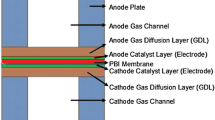Abstract
A single micro proton exchange membrane fuel cell (PEMFC) has been produced using Micro-electromechanical systems (MEMS) technology with the active area of 2.5 cm2 and channel depth of about 500 µm. A theoretical analysis is performed in this study for a novel MEMS-based design of amicro PEMFC. Themodel consists of the conservation equations of mass, momentum, species and electric current in a fully integrated finite-volume solver using the CFD-ACE+ commercial code. The polarization curves of simulation are well correlated with experimental data. Three-dimensional simulations are carried out to treat prediction and analysis of micro PEMFC temperature, current density and water distributions in two different fuel flow rates (15 cm3/min and 40 cm3/min). Simulation results show that temperature distribution within the micro PEMFC is affected by water distribution in the membrane and indicate that low and uniform temperature distribution in the membrane at low fuel flow rates leads to increased membrane water distribution and obtains superior micro PEMFC current density distribution under 0.4V operating voltage. Model predictions are well within those known for experimental mechanism phenomena.
Similar content being viewed by others
Abbreviations
- A :
-
The x-dir. position in channel (m)
- B :
-
The y-dir. position in channel (m)
- c ref :
-
Reference molar concentration (kmol·m−3)
- c RC :
-
Molar concentration of hydrogen in catalyst layer (kmol·m−3)
- c RL :
-
Molar concentration of hydrogen in channel (kmol·m−3)
- D eff :
-
Gas effective diffusivity (m2·s−1)
- D :
-
Diffusivity (m2·s−1)
- F :
-
Faraday constant (C·kmol−1)
- H C :
-
Flow channel height (m)
- H G :
-
GDL thickness (m)
- h :
-
Mixture enthalpy (J·kg−1)
- J convC :
-
The mass flow rate from channels to GDL (kg·s−1)
- J diffG :
-
The mass flow rate from GDL to catalyst layer (kg·s−1)
- j :
-
Net current density (A·m−2)
- j e :
-
Exchange current density (A·m−2)
- M :
-
Molecular weight (kg·kmol−1)
- p :
-
Absolute pressure (Pa)
- q :
-
Heat flux (J·m−2)
- R :
-
Universal gas constant (kJ·kmol−1·K−1)
- S :
-
Surface area (m2)
- Sh :
-
Sherwood number
- T :
-
Temperature (K)
- U :
-
Fluid velocity (m·s−1)
- V :
-
Volume (m3)
- Y :
-
Fluid mass fraction
- α :
-
Mass transfer coefficient
- β :
-
Kinetic constant
- ɛ :
-
Porosity
- ρ :
-
Fluid density (kg·m−3)
- η :
-
Overpotential (V)
- κ :
-
Permeability (m2)
- μ :
-
Dynamics viscosity (kg·m−1·s−1)
- σ :
-
Electrical conductivity (Ω−1·m−1)
- τ :
-
Shear stress tensor (Pa)
- τ :
-
Tortuosity
- ϕ :
-
Concentration exponent
- ω :
-
Production rate of water (kg·m−3·s−1)
- conv:
-
Convection
- diff:
-
Diffusion
- K:
-
Reaction kinetics
- N:
-
Nerst
- R:
-
Molar
- tot:
-
Total
- an:
-
Anode
- C:
-
Flow channel
- ca:
-
Cathode
- con:
-
Concentration loss
- e:
-
Exchange
- eff:
-
Effective value
- G:
-
GDL
- in:
-
Inlet
- L:
-
Catalyst layer
References
Lee, S.J., Cha, S.W., Liu, Y., et al.: High power-density polymer-electrolyte fuel cells by microfabrication. Electrochem Soc. Proceedings (2000)
Hsieh, S.S., Kuo, J.K., Hwang, C.F., et al.: A novel design and microfabrication for a micro PEMFC. Microsyst Technol. 10, 121–126 (2004)
Hsieh, S.S., Hwang, C.F., Kuo, J.K., et al.: SU-8 flow field plates for a micro PEMFC. J. Solid State Electrochem 9, 121–131 (2005)
Cha, S.W. O’Hayre, R., Park, Y.I., et al.: Electrochemical impedance investigation of flooding in micro-flow channels for proton exchange membrane fuel cells. J. Power Sources 161, 138–142 (2006)
Hsieh, S.S., Yang, S.H., Feng, C.L.: Characterization of the operational parameters of a H2/air micro PEMFC with different flow fields by impedance spectroscopy. J. Power Sources 162, 262–270 (2006)
Hsieh, S.S., Feng, C.L., Huang, C.F.: Development and performance analysis of a H2/air micro PEM fuel cell stack. J. Power Sources 163, 440–449 (2006)
Chiang, M.S., Chu, H.S.: Numerical investigation of transport component design effect on a proton exchange membrane fuel cell. J. Power Sources 160, 340–352 (2006)
Shimpalee, S., Van, Zee J.W.: Numerical studies on rib& channel dimension of flow-field on PEMFC performance. Int. J. Hydrogen Energ. 13, 842–856 (2007)
Matamoros, L., Bruggemann, D.: Numerical study on PEMFC’s geometrical parameters under different humidifying conditions. J. Power Sources 172, 253–264 (2007)
Shimpalee, S., Greenway, S., Van, Zee J.W.: The impact of channel length on PEMFC flow-field design. J. Power Sources 160, 398–406 (2006)
Liu, X., Tao, W., Li, Z., et al.: Three-dimensional transport model of PEM fuel cell with straight flow channels. J. Power Sources 158, 25–35 (2006)
Mazumder, S., Cole, J.V.: Rigorous 3-D mathematical modeling of PEM fuel cells II. Model Predictions with Liquid Water Transport. J. Electrochem. Soc. 150, 1510–1517 (2003)
Springer, T.E., Zawodzinski, T.A., Gottesfeld, S.: Polymer electrolyte fuel cell model. J. Electrochem. Soc. 138, 2334–2342 (1991)
Author information
Authors and Affiliations
Corresponding author
Rights and permissions
About this article
Cite this article
Peng, RG., Chung, CC. & Chen, CH. Experimental and numerical studies of micro PEM fuel cell. Acta Mech Sin 27, 627–635 (2011). https://doi.org/10.1007/s10409-011-0495-z
Received:
Revised:
Accepted:
Published:
Issue Date:
DOI: https://doi.org/10.1007/s10409-011-0495-z




